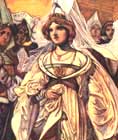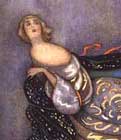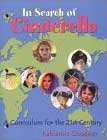
Cinderella:
345 Variants
by Marian
Roalfe Cox
SurLaLune's
Cinderella Area
SurLaLune Fairy Tales Main Page
323
Gypsy-lore Society, Journal of the, vol. iii. pp. 208-210. ("Tales in a Tent," by John Sampson.)
"DE LITTLE BULL-CALF."
ABSTRACT
Ill-treated hero (by stepfather)-- Helpful animal (bull-calf)-- Old man aid-- Hero flight on helpful animal-- Bull fights and kills various wild beasts; is killed by dragon-- Hero skins bull, inflates its biggest gut, which will kill everything he hits with it-- Princess staked down as prey for dragon-- Hero kills dragon with bull's gut, and cuts out its tongue; takes leave of princess, who ties diamond ring into his hair-- King surprised to find princess living; releases her; proclaims that her deliverer shall wed her and succeed to kingdom-- Trophy marriage test-- Impostors cut off first fingers, and show tongues of various wild beasts-- Hero, poorly clad, is turned away; after a time comes again, better dressed-- Recognition by means of diamond ring and dragon's tongue-- Happy marriage.
TABULATION
(1) Little boy pets little bull-calf which father gives him. Father dies, mother marries again, and stepfather ill-treats little boy, threatening to kill bull-calf. When little boy is feeding it with barley bread an old man appears and advises him to go away with his bull-calf to seek his fortune.-- (2) He sets Out, goes a long, long way, and reaches farmhouse, where he begs a crust of bread, half of which he gives to calf. He comes to another house, begs a bit of cheese-rind, and offers half of it to calf. "No!" says little bull-calf. "I'm going across this field into the wild wilderness, where are tigers, leopards, wolves, monkeys, and a fiery dragon. I shall kill every one, except the fiery dragon, and he'll kill me." Little boy cries at this. Bull- calf tells him to get into tree, where none can come nigh him but the monkeys, and the cheese-rind will save him from them. Then, when bull-calf is killed, the dragon will go away for a space. The boy must meanwhile get down, skin the calf, take its biggest gut, blow it out, and it will kill everything be hits with it. When fiery dragon returns he must kill it and cut out its tongue. Little boy does as bidden.-- (3) When monkeys climb up tree to him he takes the cheese and says, "I'll squeeze your heart like this flint stone." And the monkey prudently retires. Little boy watches the fighting, cheering the little bull-calf, till it is killed by the dragon.-- (4) Little boy goes on, and sees a king's daughter staked down by the hair of her head for the fiery dragon to destroy her; he sits by her talking, and will not be induced to go away ere the dragon come, but says he will overcome it. The dragon draws neat with terrible roar; little boy hits it about the face with bull's gut till it dies. But dragon has bitten off his front finger. He cuts out dragon's tongue,1 then takes leave of king's daughter.--(5) She is sad at parting from him, and ties a diamond ring into his hair. Presently king comes by, expecting to find no trace of his daughter but the prints of the place where she was. He is much surprised, learns who has saved her, unties her, and takes her home to palace.-- (6) King announces "in all the papers" that the man who has saved his daughter shall have her to wife, and shall Succeed to his kingdom and estates. Then gentlemen come from all parts of England with their front fingers cut off, and with tongues of every description. For they go about shooting wild beasts on purpose, but never can find a dragon to shoot. And little boy comes up very disconsolately once or twice, and the princess notices him. But king is angry, and turns him out, Princess feels sure she knows that boy. Kings' sons continue to present themselves, and after a time the boy comes up again, dressed a little better. King says to daughter, "I see you have an eye on that boy, and if it is to be him, it has to be him." All the other suitors are ready to kill him and wish him turned out; but king says, let him show his claim.-- (7) Then boy shows the diamond ring with princess's name in it, and the fiery dragon's tongue; and he is married to the king's daughter, and has all his estate. Stepfather now comes and wants to own him, but the young king doesn't know such a man.
NOTES
Note 72
(P. 450.) "It seems to be a common custom with hunters to cut out the tongues of the animals which they kill. Omaha hunters remove the tongue of a slain buffalo through an opening made in the animal's throat. The tongues thus removed are sacred, and may not touch any tool or metal, except when they are boiling in the kettles at the sacred tent. They are eaten as sacred food. (Third Report of the Bureau of Ethnology (Washington), p. 289 sq.) Indian bear-hunters cut out what they call the bear's little tongue (a fleshy mass under the real tongue), and keep it for good luck in hunting, or burn it to determine, from its crackling, etc., whether the soul of the slain bear is angry with them or not. (Kohl, Kitschi-Gami, ii, 251 sq.; Charlevoix, Histoire de la Nouvelle France, v, 173; Chateaubriand, Voyage en Amerique, pp. 179 sq., 184.) In folk-tales the hero commonly cuts out the tongue of the wild beast which he has slain, and preserves it as a token. The incident serves to show that the custom was a common one, since folk-tales reflect with accuracy the customs and beliefs of a primitive age. (For examples of the incident, see Blade, Contes agenais, pp. 52, 14; Dasent, "Shortshanks"; Schleicher, Litauische Märchen, p. 58; Sepp, Altbagerischer Sagenschatz, p. 114; Köhler on Gonzenbach, Sicilianische Märchen, ii, 230; Apollodorus, iii, 13, 3; Mannhardt, Antike Wald- und Feldkulte, p. 53; Poestion, Lappländische Märchen, p. 231 sq.) It may be suggested that the cutting out of the tongues is a precaution to prevent the slain animals from telling their fate to the live animals, and thus frightening away the latter. At least, this explanation harmonises with the primitive modes of thought revealed in the foregoing customs." (Frazer's Golden Bough, ii, 129, note.)
See also Grimm, No. 60, "The Two Brothers"; No. 111, "The Skilful Huntsman"; Cosquin, i, 64, "La Bete a Sept Tetes", and Remarques, pp. 66 ff., for a number of variants.
In a story in Asiatic Journal, New Series, vol. xxiv, 1837, p. 196, two princes cut off a portion of a lion's tail as trophy. The palace washerman finds dead lion, cuts off its head, and pretends to the hand of the princess. The imposture is exposed.
Alcathous, son of Peiops, kills the Cithaeronian lion that ravages the country of King Megareus, and cuts out its tongue. (Pausanias, i, 41, 4, and schol., Apollonius of Rhodes on i, 517.)
For Stories (like No. 323) in which the hero delivers a princess from a dragon, or monster (St. George and the Dragon), cf. Asbjornsen, Tales of the Fjeld, p. 223; Brueyre, "Red Etin"; Campbell, No. 4, var. i; lxiii; i, 76, 77; Chambers, pp. 262, 296; Clouston, i, 155 ff.; Comparetti, No 32, 55; Cosquin, i, 14, 19, 60, 64, 167; ii, 57, 165, 256; Day, Folk-tales of Bengal, pp. 73-7; Dennys, Folk-lore in China, etc.; Dozon, No. 14; Erdelyi-Stier, No. 1; Finamore, No. 19, p. 87; F.-L. Journal, i, 55; vi, 159, "Death of Diarmid", etc.; Friis, "Bondesonnen"; Gonzenbach, Nos. 40, 44; ii, 230; Baring Gould, Curious Myths, 297-99; The Seven Champions of Christendom, Grimm, Nos. 60, 111; Grundtvig, ii, 194; Gubernatis, Sto. Stefano. No. 23; Gipsy-lore Journal, iii, 84, 208; Hahn, No. 70; Henderson, North. Counties, 281 ff.; Household Stories from Land of Hofer, p. 214, "The Three Black Dogs"; Indian Antiquary, i, 170; Jahrbuch fur rom. u. eng. Lit., vii, 132; Katha sarit Sagara, bk. vii, ch. 42; vol. i, p. 385 (Tawney's trans.); MacInnes, comp. p. 299; Magyar Tales, p. 374; Meier, No. 29; Pitre, ii, 215; Ralston, "Ivan Popzalof," pp. 70, 347-48; Riviere, p. 195 (serpent controls water-supply; is propitiated daily with food); Sagas from the Far East, p. 18, "Gold-spitting Prince"; Schneller, No. 39; Schott, No. 10; Scott's Arabian Nights, vi, "King Yewen and his Three Sons"; Sebillot, Haute Bretagne, 1, No. 9; Stokes, pp. 65, 178, 269; Temple, Leg. of the Punjab, vol. i, p. 17 ff.; Thorpe, p. 344; Vernaleken, p. 85; Webster, pp. 80, 89; Wide-Awake Stories, 143 ff., 258 ff., 306 ff.; Wolf, Deut. M. u. S., Nos. 20, 21, and p. 82; Zingerle, ii, No. 1. Compare Perseus and Andromeda; Heracles and the daughter of Laomedon (Il., xx, 145; and see Mr. Lang's note, p. 517, of his Iliad); Bhima in the legend of "Bakabadha" (Mahabharata, see Monier Williams, Ind. Epic Poetry, and Dean Milman's "The Brahman's Lament"); the Persian romance of "Hatim Tai"; the Vedic myth of the battle between light and darkness; Indra and Vitra (in Mr. Baring Gould's opinion the legend of St. George and the Dragon is a solar myth).
Siegmund, Siegfried, and Beowulf were dragon-quellers;
Frotho (in Saxo Gram.) overpowers a venomous dragon; Thor himself
tackles the enormous midgardsworm. The worm given to the beautiful Thora
Borgarhiortr reposed on gold which grew as the worm grew. It ate an ox
at every meal. Ragnar Lodbrok slew this enormous dragon, winning the maid
for his bride, and all the gold for her dowry. (Fornald, Sog.,
i, 237-8; see Grimm, T. M., 690.) But the numerous examples of
treasure-guarding dragons need not here be cited.
Return to place in text.
Cox, Marian Roalfe. Cinderella: Three Hundred and Forty-five Variants of Cinderella, Catskin, and Cap O' Rushes, abstracted and tabulated. London: David Nutt for the Folklore Society, 1893.
While the original text of this book is out of copyright, the special formatting and compilation available on SurLaLune Fairy Tales is copyrighted. Be aware that while the original content has been honored, page numbering, footnote numbering, redesigned charts, links, and other aspects are unique to this site's version of the text. Use at your own risk. For private and fair use educational purposes only.
©Heidi
Anne Heiner, SurLaLune Fairy Tales
E-mail: surlalune@aol.com
Page last updated March 2, 2006
www.surlalunefairytales.com










